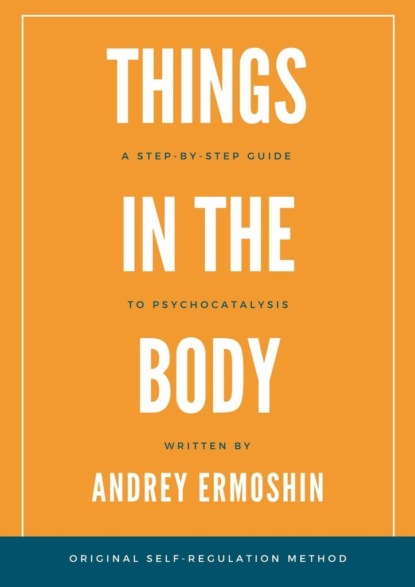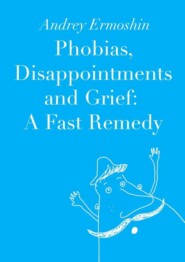По всем вопросам обращайтесь на: info@litportal.ru
(©) 2003-2024.
✖
Things in The Body
Настройки чтения
Размер шрифта
Высота строк
Поля
The ability for such awareness of the problems is an indication for the bodily psychotherapy. However, somatopsychotherapy can be also highly effective with other forms of self-consciousness and, in any case, is recommended as an additional means of «giving volume’ to a therapeutic process. Somatopsychotherapy is a good way of activating self- awareness and working out the physical aspect of the problematic experience, regardless of whether it is the main approach to change the state of a person or an ancillary one.
No matterwhere to start
There are an unlimited number of ways to start the recovery process: from a posture, from intonation, from facial expressions etc. It always turns out, that such manifestations are found in the body structure.
Fine examples of the beginning from gait features and gestures of a person are given by Arnold Mindell (USA)[16 - A. Mindell. Work with the dreaming body / / Moscow psychotherapeutic journal, №1,2, 1993.]. He organizes the process of «amplification’ of the movement, which tends to manifest, but is hidden. It is on the «lunar’ but not on the «solar’ side of consciousness. The question of the process-oriented psychotherapy is: what are you doing when you are holding your leg in such a way? The answer is: I am preparing it for a fight! The SPT question is different: where is what makes you so tense to keep your right leg like that? The answer is: there is anger in the chest. Thus, the continuation of the work is different.
N. R. Cape (Brazil)[17 - N.R.Kappe «Praise,» " Liberation.» – Proton, Sao Paulo, Brazil.] offers to pay attention to the characteristics which a person uses to describe the others. His integral psychoanalysis is based on returning to a patient their statements-projections. The SPT interiorization is achieved in a different way. «Is there something that makes you choose such words? Is it at the level of your head, chest, abdomen? What do you feel when you say that?» We move from the projection to the state which is holding it. We talk in a «topographic’ manner, using the question «where?». From nouns and adjectives that are used by a person to define the others, we move to the essence of the «speaker’, to that part of their consciousness, which «invests’ such speech behavior.
Now we will not go into details of somatopsychotherapy «debuts. Let us agree with Jung, who noted that " … in case you want to determine the patient’s complexes, you can reach the center directly from any point of the circle… you can start with the letters of the Cyrillic alphabet, with meditation in front of a crystal ball, with a prayer wheel or a modern painting, or even with a casual conversation about a trifling event. In this sense, a dream is as effective as any other starting event.[18 - C. G. Jung. Archetype and symbol. – Moscow: Renaissance, 1991, p. 30, 31.]»
It does not matter which of the rivers will bring us to the lake, and, in a sense, it does not matter what to start the recovering process with. What is important, is how to end it. According to V. N. Tsapkin, we are looking for the «invariant of options.» He noticed that the same mental content expresses itself through the absence of legs in the drawing of a person, made by the patients with clinical symptoms of astasia-abasia, as well as through their dreams, or their behaviors in a group.
In somatopsychotherapy this kind of invariant is thebodily-oriented structure of consciousness. Under other circumstances, a person expresses it in words in free associations (in the psychoanalytic model); projects on the inner screen in the form of «movie’, accompanied by sounds, smells, bodily sensations (in the NLP model); expresses behaviorally (in the procedural model). In a «somatopsychotherapeutic’ situation it appears as an object in the body of consciousness. It is like a book on the bookshelf that can be read, filmed, or performed dramatically (as in the above-mentioned models), but which is now stored in a potential state within its covers.
The direction of asking questions
Two spaces
The somatopsychotherapy questions are topographically structural: “where and what?” at the first stage, and “where to and what?” at the second one. The psychotherapist aims to help the patients find their sensation, associated with the certain experience, in their special internal space – the space of sensations. It is different from the one with the realities of the objective external world. The table which I am sitting at, the tree which I can see in front of me, the sky above me are outside my space of sensations. The space of things and the space of sensations complement each other. Both are parts of the reality of our consciousnesses. The reality associated with the external space can be called “the reality of open eyes’, whereas the internal one is “the reality of closed eyes.”
Psychocatalysis of awareness of the space of sensations reveals three areas of this «psychogenetic’ world which is parallel to the material world.
Three areas of self-awareness
The world of phenomena that opens up when referring to the “reality of sensations’ is rather rich. It consists of in-body sensations, sensations of an integral body, the “landscape’ sensations.
We will mainly be talking about in-body sensations. To begin with, we will mention the «boundary’ and «over boundary’ sensations, for example:
Someone is holding his shoulders up.
«What do you have on your shoulders?»
«A stone.» (or «a bag’, or «a log’, or «a pole with two buckets’, or
«my mother’, etc.)
(This is a state of neurotic, psychopathic responsibility, or concern.)
One more dialogue with another patient – a young woman.
«Who are you?»
«A pineapple.»
«Where are you?»
«On a plantation.»
«Is everything all right?»
«The peel’s damaged».
These are some more examples:
A man stretches his arm along the sofa, which he is sitting on, as if embracing someone invisible. You should ask him:
«Who is there?»
His answer can be:
«A cat. (or «my friend’)
«What for?»
«For calmness.» (or: «to reinforce my position.»)
A man is walking late at night. His right hand is clasped.
«Is there anything in your hand?»
«A gun.»
«Will you shoot it?»
«No.»
«What will you do with it?»
«Throw it away.»
He throws it away and starts to observe “an arsenal of weapons, both modern and ancient, including axes, etc., falling out of it. How about his left hand? Quite primitive tools like cudgels and stones are falling out of there. Disarmed, he continues his way under the highest protection with his hands lightweight and free.
The subjective space of each person, as it is described in this book, is saturated with different things and essences. Each of the elements of this internal world is «alive’ only because of a certain energy current, formed and fed by its carrier.
Perhaps, that is what Jung called «the semantic field[19 - Jung, C. G. Synchronicity: The Collection – Moscow: Refl-Buk, K.: Vakler, 1997.]», Menegetti – the psychosemantic field, Arnold Mindell – «the field, the area in space, within which the force lines operate[20 - Mindell E. Psychotherapy as a spiritual practice. – M.: Independent firm «Class», 1997.]», Vasily Nalimov – «the Semantic Universe[21 - Nalimov V. V., Drogalina J. A. The reality of the unreal. Probabilistic model of the unconscious. – Moscow: World of ideas, Akron, 1995].»
This work is focused on the phenomena of a person’s self-consciousness of their own mental space, namely, their in-body space. Knowing about the possibility of talking about «hallucinations’, somatopsychotherapy prefers to be interested in what «subsidizes’ their being, whatcharge is in the body consciousness. «Where is the feeling that makes you get armed?» (The feeling of fear in the stomach). «Where is the feeling that makes you shoulder the burden?»(The feeling of guilt in the chest).
Correlations
Here are some examples of correlation between a person’s awareness of the ‘body composition’, their own holistic image and “landscape’.
A woman feels that the cause of her deathly fatigue, which she complained of initially, is her greed. It comes out in the image of her gnarled hands with claws running into a bag, tied on her wrists, which turns out to be empty. She realizes herself as a rat, carrying everything into her hole.
Another woman has not left her house for fear of peeing in public for about eight years. In her stomach there is the sensation of a hot heavy lump, pulling together all her forces. The rest of her body is completely devastated, cold, and trembling. She feels like a fluffy animal-marten, locked in a cage.
A young man of twenty years old, suffering from inability to satisfy his sexual needs and experiencing failure in dating girls, feels on the hand a bracelet with spikes inside it which hurt him. It is the image of the painful circumstances that do not allow him to obtain the necessary warmth. He says, «I’m freezing, I’m cold!» In his chest there a is a black cloud with the solid black ice in it.







